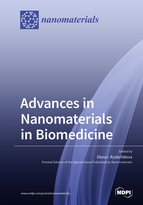Advances in Nanomaterials in Biomedicine
A special issue of Nanomaterials (ISSN 2079-4991). This special issue belongs to the section "Biology and Medicines".
Deadline for manuscript submissions: closed (31 August 2020) | Viewed by 82563
Special Issue Editor
Interests: multilevel nanoconstructions; mechanisms of nanoparticles interaction with a cell; nucleic acid delivery; spheroid model; electron microscopy; antimicrobial peptides; cell ultrastructure
Special Issues, Collections and Topics in MDPI journals
Special Issue Information
Dear colleagues,
The Special Issue “Advances in Nanomaterials in Biomedicine” is addressed to investigators working on the application of nanomaterials in biomedicine. What is biomedicine? Apparently, everyone intuitively understands when trying to pinpoint this area of knowledge that an absence of clarity is to be expected. Memidex online dictionary defines biomedicine as “a branch of medical science that applies biological and physiological principles to clinical practice”, and gives 10 more definitions that do not make the subject of biomedicine clearer.
The very broad definition of biomedicine means that this Special Issue covers a variety of nanotechnology applications in experimental and preclinical studies destined for medicine. Research articles and reviews are invited to “Advances in Nanomaterials in Biomedicine” Special Issue to gather information about achievements in various fields of nanotechnology connected to different branches of biomedicine. We hope that this Special Issue will serve as a kind of multidisciplinary congress, allowing one to discuss developments in the field of nanomaterial application in biomedical research, including but not limited to the following:
- New approaches using nanomaterials to diagnose various disease, including cancer and infections;
- The use of nanomaterials to improve the preservation and storage duration of medical preparations;
- Nanomaterials providing targeted delivery of medical preparations;
- Nanomaterials in tissue engineering and prosthetics;
- Nanomaterials to improve patient care, new effective antimicrobial agents.
Prof. Elena I. Ryabchikova
Guest Editor
Manuscript Submission Information
Manuscripts should be submitted online at www.mdpi.com by registering and logging in to this website. Once you are registered, click here to go to the submission form. Manuscripts can be submitted until the deadline. All submissions that pass pre-check are peer-reviewed. Accepted papers will be published continuously in the journal (as soon as accepted) and will be listed together on the special issue website. Research articles, review articles as well as short communications are invited. For planned papers, a title and short abstract (about 100 words) can be sent to the Editorial Office for announcement on this website.
Submitted manuscripts should not have been published previously, nor be under consideration for publication elsewhere (except conference proceedings papers). All manuscripts are thoroughly refereed through a single-blind peer-review process. A guide for authors and other relevant information for submission of manuscripts is available on the Instructions for Authors page. Nanomaterials is an international peer-reviewed open access semimonthly journal published by MDPI.
Please visit the Instructions for Authors page before submitting a manuscript. The Article Processing Charge (APC) for publication in this open access journal is 2900 CHF (Swiss Francs). Submitted papers should be well formatted and use good English. Authors may use MDPI's English editing service prior to publication or during author revisions.
Keywords
- Nanotechnology
- Biocompatible nanomaterials
- Diagnostics
- Storage of medicines
- Targeted drug delivery
- Nanomedicine
- Nanocarriers
- Tissue engineering.







